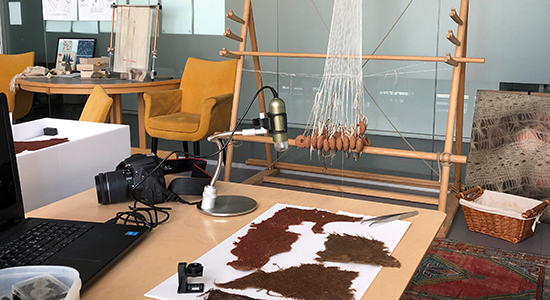CTR TexLab: Interdisciplinary hub for the study of past cloth cultures
The Centre for Textile Research at UCPH is building a new hub for integrated research in cloth cultures. The hub rests upon the expertise of our multi-disciplinary network of experts, spanning archaeology, textile and animal skin research, history, art history, terminology, museums, conservation, digital and natural sciences. Together, we will work at the TexLab in CTR and organise research activities, training and teaching events.

Since its inception, CTR has worked towards developing and disseminating textile research and, in the past 15 years, textile research has indeed blossomed. It now integrates many different techniques and methods, often based on the development of natural sciences such as palaeoproteomics and aDNA, or fibre and dye analyses. However, teams, infrastructures, and research agendas often remain isolated within different departments and academic fields.
CTR hopes to act as a bridge between these different partners. Such cohesion is necessary to merge cutting-edge but isolated scientific results into a larger picture, where context and interpretation are key, in order to build together global archaeological and historical narratives.
The aim of the CTR TexLab is to generate new and more integrated research results by creating a collaborative platform for the combined study of cloth cultures, digital and natural sciences, merging resources and expertise into shared research programmes and outputs.
Among Humanity’s rich material landscape, garments form a particularly revealing class of artifacts, as they surround people’s bodies from birth to death and convey messages about the individual’s social status, resources, community belonging and cultural identity. As the result of a complex chaîne opératoire, textiles and leather also bring precious information on the local economy and craft techniques as well as on consumption patterns and social impact.
Therefore, the study of past cloth cultures needs to be conceived as an integrated and interdisciplinary research activity by merging high-definition analyses of ancient textile and skin artefacts and the deep understanding of their archaeological, historical and anthropological contexts.
We hope to demonstrate the potentials and limitations of scientific methods in the analysis of archaeological garments and cloth, promoting a source-critical perspective, building new theoretical frameworks and offering new interpretations.
The objectives of the hub are:
- To develop study protocols, gather best practice, and establish new standards of how to use natural and digital sciences in textile and animal skin research.
- To integrate this new approach in both archaeology and science teaching curricula, through summer courses, seminars and training workshops open to UCPH students, foreign students, archaeologists and museum staff.
- To create a truly interdisciplinary research environment and work processes, in which archaeologists cease to be the “data providers” and the scientists the “data identifiers”, and where questions, objects, study protocols and historical discussions are elaborated in partnerships of two-ways learning.
Scientific methods include palaeoproteomics, aDNA, isotopic tracing, radiocarbon dating, biochemical identification of dyestuff (HPLC-MS), new imaging techniques, as well as advanced archaeological recording systems. Together, these methods can bring significant answers to fundamental questions about archaeological finds, such as What is it made of? Where does it come from? How was it made?
Through the lens of natural sciences, ancient garments reflect the incredible diversity of natural resources used by past populations to make garments. Fragments of animal skins or fur, of silk or wool textiles, of linen yarn or tree bark cloth, reveal past eco-systems, trading networks, and intertwined cultural identities.
The hub welcomes researchers and students in need of specialised supervision and analytical tools for the study of archaeological textile and skin artefacts. The CTR TexLab houses microscopes as well as the necessary software to create databases, process pictures and illustrations, maps, and 3D models. It also houses looms and other reconstructions of archaeological textile tools, as well as a study collection of archaeological textiles, which are available for study for all users/participants.
Together with our partners, we can provide researchers with assessments and consultations to prepare and lead textile- and animal skin-related research projects. Our team can moreover assist in designing analytical protocols involving experimental archaeology and testing through natural sciences.
We will also provide support and training to researchers, especially to early career researchers and archaeologists.
Likewise, we offer supervision and training to students on all academic levels.
The hub will organize training workshops, seminars and a summer school open to both UCPH students from Humanities and Sciences, as well as external students and scholars (from museums, conservation, archaeology, etc…). More information will follow.
Archaeology, experimental archaeology, textile research, terminology, conservation, SEM-microscopy and other advanced imagery techniques, palaeoproteomics, aDNA, visualization and analyses of dyes/pigments, paleobotany, museums.
Partners
Annual reports
Contact
The coordinators of the TexLab at CTR are:
- Head of Centre Eva Andersson Strand
- Dr. Elsa Yvanez
- Marie Curie Fellow Chiara Serana Spinazzi-Lucchesi
If you are interested in coming to CTR or otherwise develop your research in textile and skin archaeology, please contact us at ctr@hum.ku.dk
